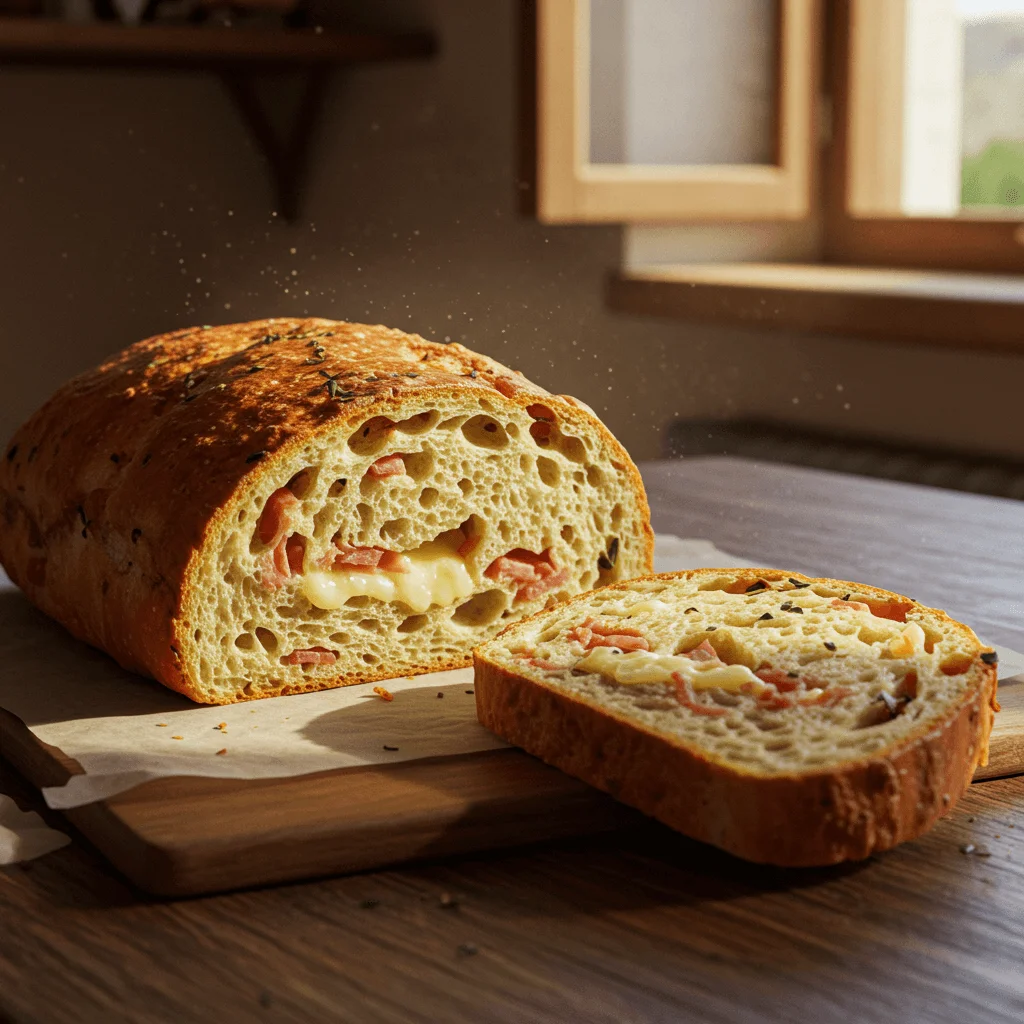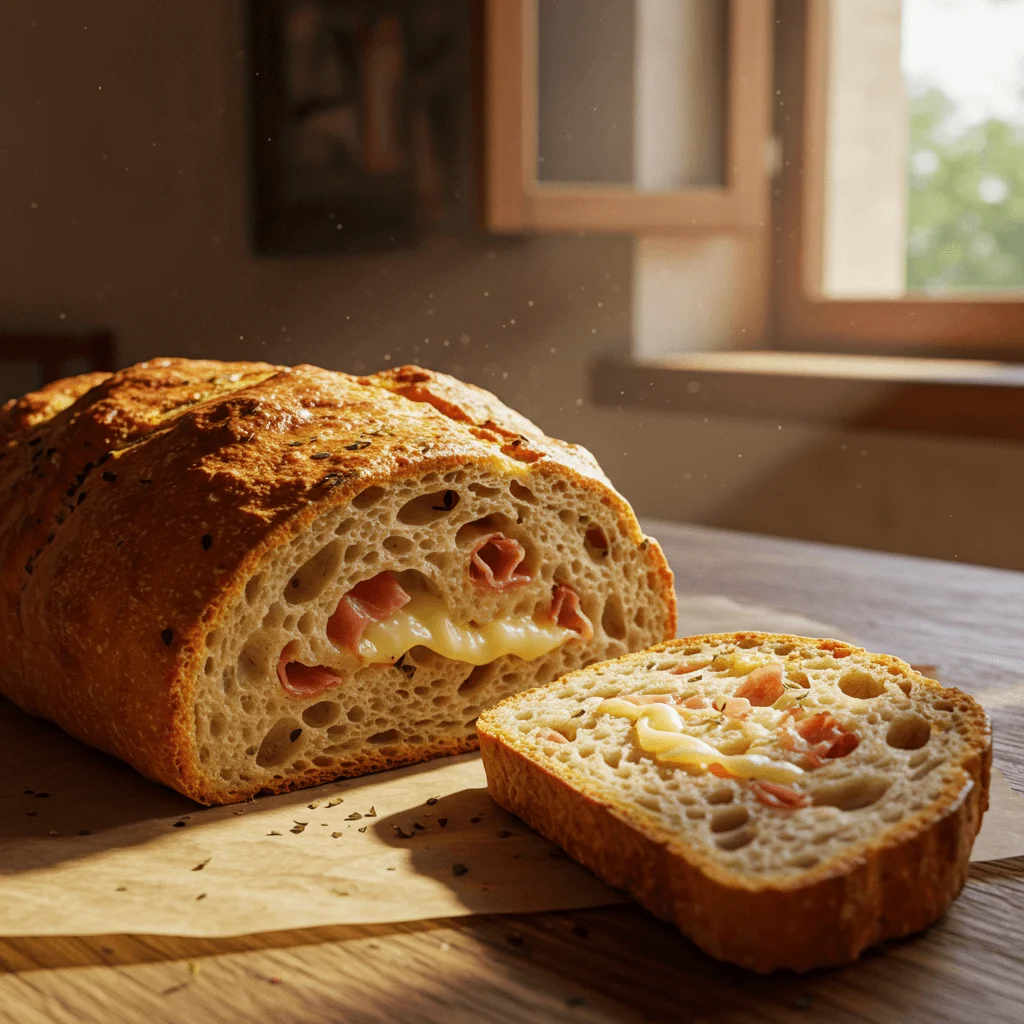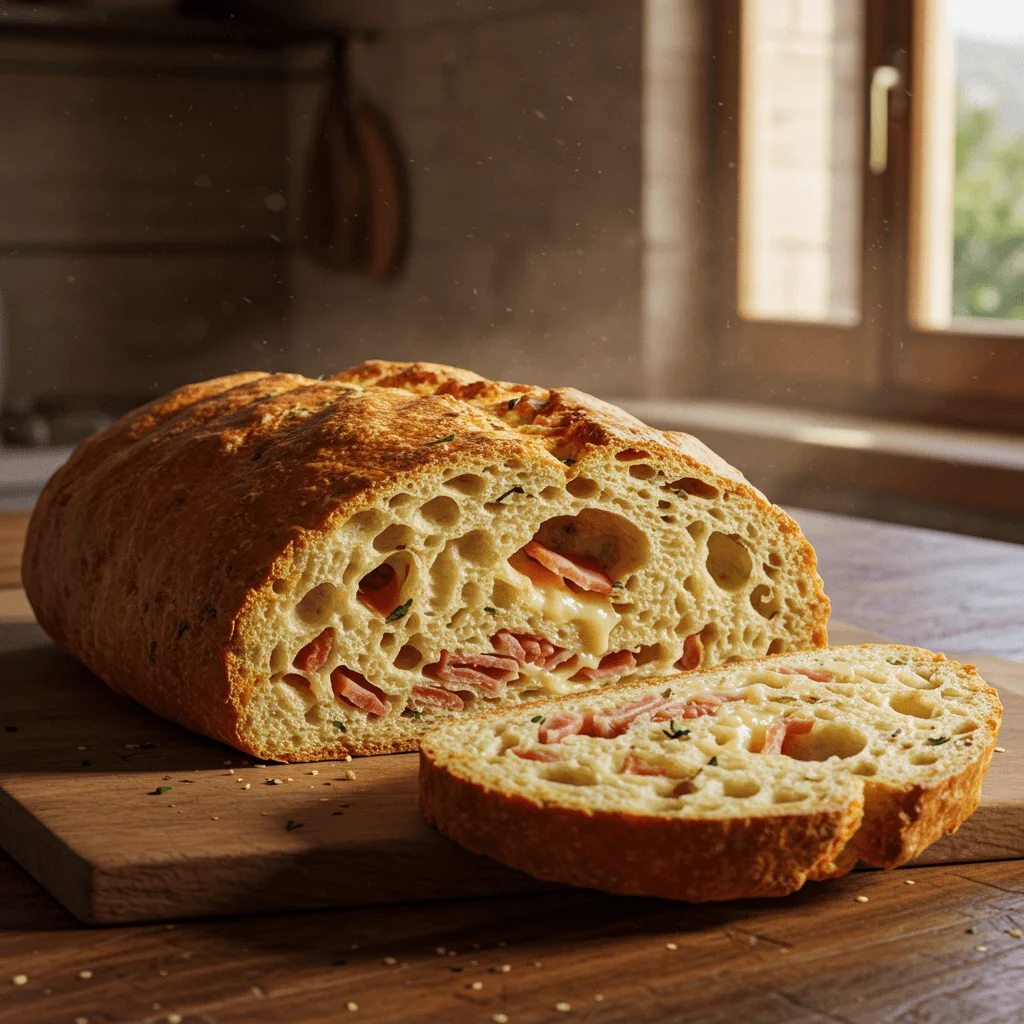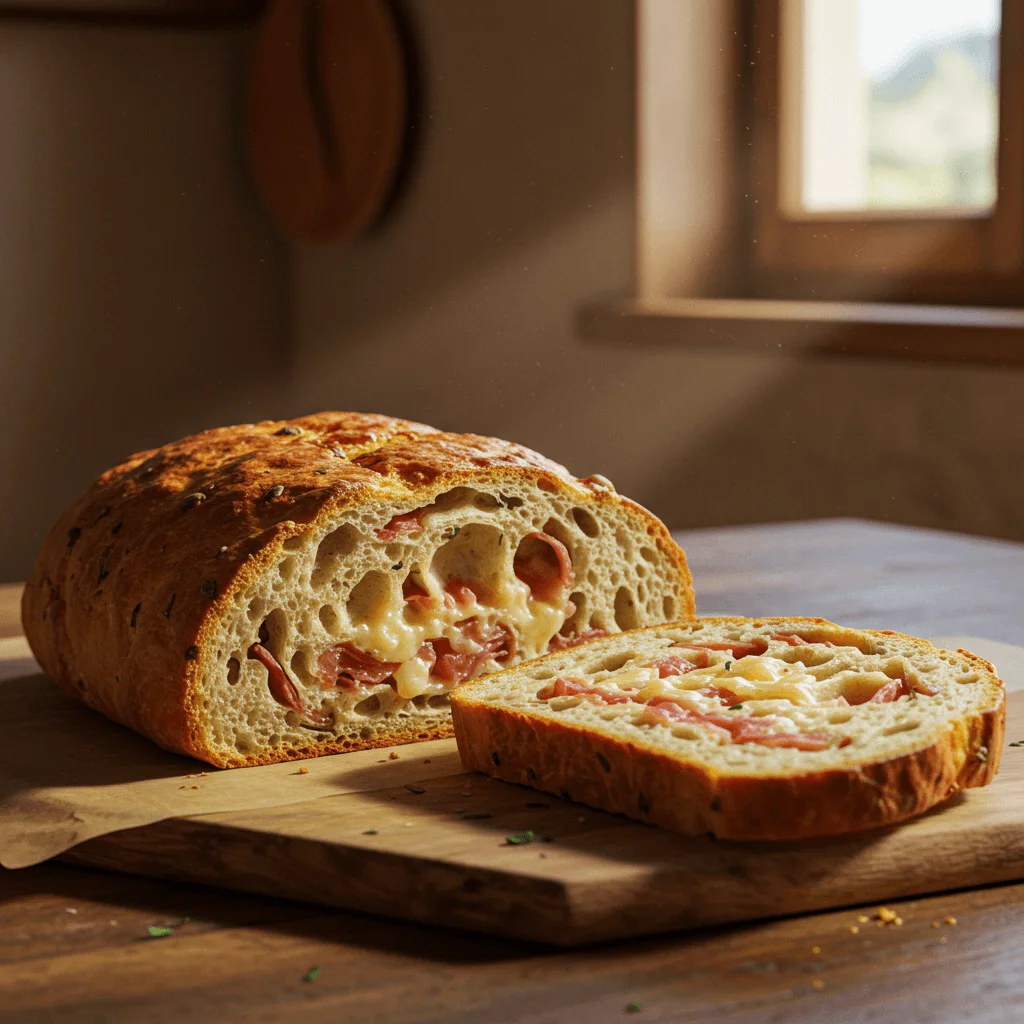Introduction
If you love the rich flavors of Italian cuisine, prosciutto bread is a must-try! This savory and flavorful bread combines the crispy, golden crust of artisan bread with Prosciutto di Parma’s salty, melt-in-your-mouth goodness. Traditionally enjoyed in Italy as a snack or appetizer, this rustic loaf is perfect for pairing with cheese, wine, or a charcuterie board.
Making homemade prosciutto bread is easier than you think. You can create a bakery-quality loaf in your kitchen with just a few simple ingredients like flour, yeast, olive oil, and prosciutto. Whether you enjoy it warm out of the oven or toasted with a drizzle of olive oil, this bread is a delicious addition to any meal. Ready to bake your own? Let’s get started!
What Makes Prosciutto Bread So Special?

A Traditional Italian Delight
Prosciutto bread is more than just a delicious loaf—it’s a piece of Italian culinary history. Originating from Italy, this savory bread combines the country’s love for artisan baking and high-quality cured meats, creating a flavorful and rustic delicacy that has been enjoyed for generations.
The Italian Roots of Prosciutto Bread
In Italy, bread and cured meats have always been staples in traditional cuisine. The combination of freshly baked dough and savory prosciutto was a natural evolution, especially in regions where charcuterie and artisanal bread-making flourished. This bread became particularly popular in Southern Italy, where it was often made for holidays, family gatherings, and special occasions.
A Popular Bread for Every Occasion
Prosciutto bread is commonly enjoyed as an appetizer, side dish, or standalone snack. It pairs exceptionally well with:
- Cheese platters – Complementing the salty prosciutto with mozzarella, Parmesan, or ricotta.
- Olive oil and balsamic vinegar – Enhancing the bread’s natural flavors with a simple dip.
- Soups and salads – Adding a hearty, savory touch to light dishes.
- Italian wines, especially Chianti or Pinot Grigio, balance the richness of prosciutto.
Regional Variations and Creative Twists
While the traditional Italian prosciutto bread recipe keeps it simple with just prosciutto and dough, some regions and home bakers have put their spin on it by incorporating:
- Cheese – Parmesan, provolone, or asiago for an extra layer of flavor.
- Herbs and spices – Garlic, rosemary, or black pepper to enhance the aroma.
- Olives or sun-dried tomatoes – Adding a Mediterranean twist.
This classic bread continues to be a beloved favorite in Italian households and is now gaining popularity worldwide as homebakers discover its irresistible taste. Whether you stick to the traditional recipe or add creative ingredients, prosciutto bread is a testament to Italy’s rich culinary heritage.
Key Ingredients for the Perfect Prosciutto Bread
The secret to making perfect prosciutto bread lies in choosing high-quality ingredients that enhance the bread’s texture and flavor. While the recipe is simple, each ingredient plays a vital role in achieving the right balance of crispiness, softness, and savory goodness. Let’s take a closer look at the key components of this delicious bread.
1. Prosciutto – The Star Ingredient
Prosciutto di Parma or Prosciutto San Daniele are the best choices for making authentic Italian prosciutto bread. This thinly sliced, dry-cured ham has a delicate, salty flavor that blends beautifully into the dough, infusing every bite with savory richness.
Tips for Choosing and Using Prosciutto:
- Opt for high-quality, aged prosciutto for the best flavor.
- Slice it thinly so it incorporates well into the dough.
- Tear or chop the slices into small pieces for even distribution.
- Avoid overly moist or thick-cut ham, which can make the bread dense.
2. Flour – The Foundation of the Dough
The type of flour you use directly impacts the texture of your prosciutto bread. A strong flour with high protein content is ideal for creating a sturdy yet soft loaf.
Best Flour Choices for Prosciutto Bread:
- Bread Flour – The best option for a chewy and airy texture due to its high gluten content.
- All-Purpose Flour – Works well if you want a slightly lighter loaf.
- 00 Flour – This ultra-fine flour is often used in Italian bread-making, resulting in a delicate crumb and crispy crust.
Tip: If you want an extra rustic feel, mix bread flour with a little whole wheat flour to add more depth of flavor.
3. Yeast – The Leavening Agent
Yeast is essential for giving prosciutto bread its airy rise and soft texture. You can use instant or active dry yeast, depending on your preference.
- Instant Yeast – Works faster and can be mixed directly into the dry ingredients.
- Active Dry Yeast – This needs to be dissolved in warm water before adding to the dough.
Tip: Let the dough rise slowly for enhanced flavor. A longer fermentation (even overnight in the fridge) helps develop a more complex, slightly tangy taste.
4. Olive Oil – Enhancing Moisture and Flavor
A generous drizzle of extra virgin olive oil adds moisture to the dough and enhances the bread’s overall flavor. It helps create a crispy crust while keeping the interior soft and tender.
Best Olive Oil to Use:
- Cold-pressed extra virgin olive oil for the best aroma and richness.
- Infused olive oils (like garlic or rosemary) for extra depth of flavor.
Tip: Brush the top of the loaf with a little olive oil before baking for a golden-brown finish.
5. Salt – Bringing Out the Flavors
While prosciutto already has a natural saltiness, a small amount of additional salt in the dough enhances the overall taste and strengthens the gluten structure.
Tips for Using Salt in Prosciutto Bread:
- Use sea salt or kosher salt for a more natural taste.
- Avoid adding salt directly to the yeast, as it can inhibit fermentation.
- Balance the salt with the prosciutto to avoid making the bread too salty.
6. Optional Add-Ins for Extra Flavor
While the classic prosciutto bread keeps it simple, you can elevate the flavor with additional ingredients:
- Cheese – Parmesan, mozzarella, or asiago for a melty, cheesy touch.
- Fresh Herbs – Rosemary, oregano, or thyme add an aromatic dimension.
- Garlic & Black Pepper – For an extra savory kick.
- Red Pepper Flakes – If you like a hint of spice.
Final Thoughts
High-quality ingredients are key to achieving the perfect prosciutto bread—crispy on the outside, soft and flavorful on the inside. You can bake a savory Italian masterpiece perfect for any occasion with the right flour, yeast, olive oil, and premium prosciutto.
Tips for Achieving the Best Texture and Flavor
Making perfect prosciutto bread balances texture, moisture, and flavor. The right techniques can take your bread from good to exceptional, ensuring a crispy golden crust, a soft and airy interior, and the perfect distribution of savory prosciutto. Below are some essential baking tips to help you always achieve the best results.
1. Choose High-Quality Ingredients
The quality of your ingredients directly affects the texture and flavor of your bread. Prosciutto di Parma, bread flour, and extra virgin olive oil are key to achieving an authentic and delicious loaf.
- Use finely milled bread flour for a light yet chewy texture.
- Opt for high-quality cured prosciutto to get the best depth of flavor.
- Use extra virgin olive oil for added moisture and a rich aroma.
Tip: Avoid using low-quality ham or thick-cut prosciutto, as it can make the bread greasy and dense.
2. Knead the Dough Properly
Kneading helps develop gluten, which gives your bread structure and chewiness. However, over-kneading or under-kneading can affect the final result.
- By Hand: Knead for 8-10 minutes until the dough is smooth and elastic.
- Using a Stand Mixer: Knead with the dough hook on medium speed for 5-7 minutes.
How to Know When Your Dough is Ready:
- Perform the windowpane test: Stretch a small piece of dough between your fingers—if it becomes thin and translucent without tearing, the gluten is well-developed.
- The dough should be slightly sticky but not too wet.
Tip: If the dough feels too dry, add a teaspoon of water at a time. If it’s too wet, sprinkle in a bit more flour.
3. Allow Enough Time for the Dough to Rise
The proofing process is crucial for achieving a light, airy texture. The bread may turn out too dense if the dough doesn’t rise properly.
- First Rise (Bulk Fermentation): Let the dough rise warmly for 1-2 hours or until it doubles in size.
- Second Rise (Final Proof): After shaping the dough, let it rise again for 30-45 minutes before baking.
Tip: Try a cold fermentation for extra flavor by letting the dough rise in the refrigerator overnight. This slows the yeast activity, allowing more complex flavors to develop.
4. Distribute the Prosciutto Evenly
To ensure every bite is packed with savory goodness, fold the prosciutto pieces into the dough rather than just layering them on top.
- Cut or tear the prosciutto into small pieces to spread evenly throughout the bread.
- Layer the prosciutto as you shape the dough to create a marbled effect.
- Avoid clumping too much prosciutto in one spot, which can cause uneven baking.
Tip: If you like a crispier texture, reserve a few slices to place on top of the dough before baking.
5. Use Steam for a Crispy Crust
A crusty exterior is one of the hallmarks of great prosciutto bread. Creating Steam in the oven helps develop that golden, crackly crust.
Ways to create Steam while baking:
- Use a baking stone: This retains heat and mimics a professional bread oven.
- Add a pan of hot water: Place a tray of hot water on the bottom rack of the oven to generate Steam.
- Spray water into the oven: Mist the walls in the first 5 minutes of baking.
Tip: Avoid opening the oven door too often while baking, as it can cause heat loss and prevent proper crust formation.
6. Bake at the Right Temperature
Getting the oven temperature right is essential for even baking and achieving the perfect texture.
- Preheat your oven to 400°F (200°C) for a crispy crust and well-risen loaf.
- Bake for 25-30 minutes until the bread is golden brown and sounds hollow when tapped on the bottom.
- Cover the crust loosely with aluminum foil in the last 10 minutes if the crust browns too quickly.
Tip: Let the bread cool for at least 15-20 minutes before slicing to allow the texture to set. Cutting too early can make the bread gummy.
7. Enhance the Flavor with Add-Ins
While classic prosciutto bread is delicious on its own, you can add extra ingredients to customize the flavor:
- Cheese: Parmesan, Asiago, or provolone for extra richness.
- Herbs: Fresh rosemary, thyme, or oregano for a fragrant touch.
- Garlic or black pepper: Adds a slight kick to complement the prosciutto.
- Chili flakes: A hint of spice for a bold twist.
Tip: Brush the bread with olive oil or melted butter before serving to enhance its flavor and shine.
Final Thoughts
Following these tips, you can make perfectly textured and flavorful prosciutto bread every time. The key is to use high-quality ingredients, knead the dough properly, allow enough time to rise, and bake at the right temperature for a crispy yet tender loaf.
Step-by-Step Guide to Making Prosciutto Bread

Preparing the Dough for a Fluffy Texture
Achieving a light and airy texture in prosciutto bread starts with properly preparing the dough. The right techniques ensure that the bread has the perfect balance of chewiness and softness while allowing the flavors of Prosciutto to shine through. Below, we’ll explore the essential steps to prepare your dough for a fluffy, well-risen loaf.
1. Choosing the Right Flour for Structure
The type of flour you use directly affects the texture of your bread. Since Prosciutto bread benefits from a slight chewiness while remaining soft inside, selecting the right flour is important.
- Bread flour is the best choice because it contains higher protein (Gluten) levels, which help create structure and elasticity.
- All-purpose flour can be used if necessary but may result in a slightly softer and less structured loaf.
- 00 flour (Italian-style flour) can provide a more delicate texture while maintaining a good rise.
Tip: If you want an extra tender crumb, mix bread flour with a small amount of all-purpose flour for a balanced texture.
2. Measuring Ingredients Accurately
Precision is key when preparing the dough. Small miscalculations in flour, water, or yeast can lead to a dough that is too dense, sticky, or dry.
- Use a kitchen scale to measure flour instead of cups, as scooping can lead to inconsistencies.
- Check your yeast to make sure it’s fresh. Expired yeast may not activate properly, leading to a dense bread.
- Keep the right flour-to-water ratio—too much flour makes the dough stiff, while too much water makes it sticky and difficult to work with.
Tip: If your dough feels too dry, add a teaspoon of water at a time to adjust. If it’s too wet, sprinkle a small amount of flour while kneading.
3. Activating the Yeast for Proper Rising
To ensure your bread has a fluffy texture, the yeast must be properly activated to create the necessary air pockets.
- For active dry yeast: Dissolve it in warm water (95-105°F or 35-40°C) with a teaspoon of sugar. Let it sit for 5-10 minutes until it becomes foamy.
- For instant yeast: You can mix it directly into the flour without dissolving it in water.
- For fresh yeast: Crumble it into warm water and let it dissolve before adding to the dough.
Tip: If your yeast doesn’t bubble or foam after 10 minutes, it may be expired—replace it with fresh yeast before continuing.
4. Kneading the Dough to Develop Gluten
Kneading is one of the most important steps in achieving a fluffy yet structured texture. Proper kneading develops Gluten, which traps air bubbles and gives the bread its soft yet elastic structure.
- By hand: Knead the dough on a floured surface for 8-10 minutes, stretching and folding it repeatedly.
- By stand mixer: Use the dough hook attachment on medium speed for 5-7 minutes until the dough becomes smooth and elastic.
- The dough should feel soft, slightly sticky, and bounce back when pressed.
How to Tell if the Dough is Ready:
- Perform the windowpane test: Stretch a small piece of dough between your fingers—if it forms a thin, translucent membrane without tearing, it’s kneaded enough.
- If the dough tears easily, continue kneading for another 1-2 minutes.
Tip: Avoid over-kneading, especially with a mixer, as it can make the dough too tight and result in a dense loaf.
5. Let the Dough Rise for Airiness
Letting the dough rise properly is essential for achieving the fluffy texture that makes prosciutto bread delicious. This step allows the yeast to create air pockets inside the dough.
- First Rise (Bulk Fermentation):
- Place the dough in a greased bowl, cover it with a clean towel, and let it rise in a warm place for 1-2 hours or until doubled in size.
- Place the dough in a slightly warmed oven (turned off) or near a warm window if your kitchen is cold.
- Second Rise (After Shaping):
- Once the dough is shaped, let it rise again for 30-45 minutes before baking.
- This step ensures a final boost in airiness before the bread goes into the oven.
Tip: For an even fluffier texture, try an overnight cold fermentation by letting the dough rise in the refrigerator overnight. This slow rise develops deeper flavors while improving the texture.
6. Folding in the Prosciutto Properly
To prevent the Prosciutto from weighing down the dough, folding it in strategically rather than mixing it all at once is important.
- Cut the Prosciutto into small pieces so it distributes evenly.
- Layer the Prosciutto in stages as you shape the dough, folding it gently to prevent overworking.
- Avoid pressing the dough too much after adding the Prosciutto, as this can deflate the air pockets needed for a fluffy texture.
Tip: Sprinkle a bit of grated parmesan or pecorino romano along with the Prosciutto for added depth of flavor.
7. Controlling Moisture for the Perfect Balance
The moisture level in the dough plays a critical role in achieving the right balance between a fluffy interior and a crisp crust.
- If the dough is too dry, it will result in tough, dense bread.
- If the dough is too wet, it may not rise properly and become gummy.
Tips for Maintaining Moisture:
- Use a lightly greased bowl when proofing to prevent the dough from drying out.
- Cover the dough with plastic wrap or a damp towel to keep moisture in.
- If baking in a dry climate, place a small dish of water in the oven while baking to add steam.
Final Thoughts
Properly preparing the dough is the foundation of great prosciutto bread. By choosing high-quality flour, kneading properly, letting the dough rise sufficiently, and carefully folding in the Prosciutto, you can achieve a light, airy, and flavorful loaf with a perfect texture.
Incorporating Prosciutto and Other Ingredients
Adding prosciutto and complementary ingredients at the right stage is key to enhancing the flavor and texture of prosciutto bread. This process requires a delicate balance to ensure that the prosciutto integrates seamlessly into the dough while maintaining its signature taste and texture. Below, we’ll go over when and how to add prosciutto and other ingredients that can elevate the bread’s overall flavor.
1. Choosing the Best Prosciutto for Bread
Not all prosciutto is created equal, and choosing the right type will impact the final taste of your bread.
- Prosciutto di Parma or San Daniele – These high-quality Italian dry-cured hams perfectly balance saltiness and richness.
- Domestic prosciutto – Often found in local grocery stores, this option can be slightly saltier but works well in bread.
- Aged prosciutto – Offers a more intense umami flavor, but softer, less aged varieties tend to blend better into the dough.
Tip: If using saltier prosciutto, adjust the salt in the dough to prevent the bread from becoming overly salty.
2. Preparing the Prosciutto for Incorporation
Rather than simply mixing large pieces of prosciutto into the dough, proper preparation ensures even distribution and prevents overly dense meat pockets.
- Slice or tear the prosciutto into small pieces (around ½ to 1 inch) to ensure an even spread throughout the dough.
- Avoid overly thick slices, as they may cause uneven baking and create dense spots in the bread.
- Let the prosciutto reach room temperature before incorporating it to maintain its soft texture and prevent toughness in the baked loaf.
Tip: Lightly crisping the prosciutto in a pan before adding it can enhance its smoky flavor and create subtle crunchy bits throughout the bread.
3. When to Add Prosciutto to the Dough
Timing is crucial when incorporating prosciutto to ensure it doesn’t break down too much or interfere with the dough’s ability to rise properly.
- After the first proofing, add prosciutto after the dough has risen, which allows the gluten structure to develop without interference.
- During shaping – Folding the prosciutto into the dough while shaping the loaf helps distribute it more evenly.
- Avoid adding it too early – If added before kneading, the salt and fat in the prosciutto can interfere with gluten development, leading to denser bread.
Best Technique:
- Gently stretch the dough into a rectangle.
- Evenly scatter the prosciutto pieces across the surface.
- Fold the dough over itself in layers, lightly pressing to seal the layers together.
- Shape the dough into a loaf or rolls, ensuring the prosciutto remains distributed throughout.
Tip: Avoid overmixing after adding prosciutto, as excessive handling can cause the dough to deflate and result in a dense loaf.
4. Enhancing Flavor with Complementary Ingredients
While prosciutto is the star ingredient, adding a few complementary flavors can elevate the taste of your bread even further.
Cheese Options
- Parmesan or Pecorino Romano – Aged cheeses add a salty, nutty depth.
- Mozzarella – Provides a creamy texture and a mild, milky flavor.
- Gruyère or Fontina – Melts beautifully, creating a richer bite.
Herbs and Seasonings
- Fresh rosemary or thyme – Infuses a subtle earthiness that complements prosciutto.
- Cracked black pepper – Adds a mild spiciness to balance the richness.
- Garlic powder or roasted garlic – Enhances the savory profile.
Other Add-Ins for Extra Texture and Flavor
- Sun-dried tomatoes – Provide a slight tang and contrast to the salty prosciutto.
- Black or green olives – Bring a briny, Mediterranean depth.
- Caramelized onions – Add a touch of sweetness to balance the saltiness.
Tip: If using multiple add-ins, keep the total volume in check to prevent overloading the dough and affecting its structure.
5. Preventing Sogginess or Uneven Baking
Since prosciutto has a natural fat content, it’s important to prevent the bread from becoming too greasy or soggy.
- Pat prosciutto dry before incorporating it to remove excess moisture.
- Avoid clustering too many pieces in one spot, which can lead to pockets of oil.
- Bake at the right temperature (375–400°F / 190–200°C) to ensure the bread sets properly without becoming overly dense.
Final Thoughts
Incorporating prosciutto and other ingredients properly ensures that every bite of your bread is flavorful, well-balanced, and texturally perfect. By selecting high-quality prosciutto, preparing it correctly, adding it at the right stage, and complementing it with cheese, herbs, or other flavors, you can create a savory, delicious prosciutto bread perfect for any occasion.
Baking and Serving Prosciutto Bread

Once the dough has been properly prepared and the prosciutto and other ingredients have been incorporated, it’s time for the final steps—baking and serving. These steps are crucial in ensuring the bread develops a crispy crust, a fluffy interior, and a rich, savory flavor. Below, we’ll cover the ideal baking techniques, tips for achieving the perfect texture, and the best ways to serve and enjoy prosciutto bread.
1. Preheating and Preparing the Oven
Baking prosciutto bread at the right temperature is essential for achieving a golden, crispy crust while keeping the inside soft and airy.
- Preheat your oven to 375–400°F (190–200°C) – This temperature range allows for even baking without over-drying the bread.
- Use a baking stone or steel – Placing the dough on a preheated stone or steel creates a crispier bottom crust.
- Steam for the first 10 minutes – Introducing steam into the oven (by placing a small tray of water on the bottom rack or spraying the walls with water) helps develop a crackly crust.
Tip: If using a convection oven, reduce the temperature by about 25°F (15°C) to prevent over-browning.
2. Baking Prosciutto Bread to Perfection
The way the bread bakes determines its final texture, flavor, and appearance.
- Scoring the dough – Use a sharp knife or bread lame to make shallow slashes on the dough’s surface. This allows for controlled expansion while baking.
- Baking time – Most loaves bake for 25–35 minutes, while rolls or smaller portions take 15–20 minutes.
- Checking for doneness – The bread is ready when:
- The crust is golden brown.
- It sounds hollow when tapped on the bottom.
- An inserted thermometer reads 190–200°F (88–93°C) in the center.
Tip: If the crust is browning too quickly, tent the bread halfway through baking with aluminum foil.
3. Cooling for the Best Texture
Cooling prosciutto bread properly prevents a gummy texture and allows the flavors to develop fully.
- Let the bread rest on a wire rack for at least 30 minutes before slicing. Cutting too early releases steam, making the bread dense.
- Avoid covering the bread immediately – This traps moisture and softens the crust.
- For extra crispness, place the loaf back in a 300°F (150°C) oven for 5 minutes before serving.
Tip: Making smaller rolls or baguette-style loaves may require less cooling time—about 15–20 minutes.
4. Best Ways to Serve Prosciutto Bread
Prosciutto bread is versatile and pairs well with various foods, making it perfect for meals, appetizers, or snacks.
As an Appetizer or Side
- Served warm with butter or olive oil – A simple yet delicious way to highlight the bread’s flavors.
- Paired with cheeses like Parmesan, Pecorino, or fresh mozzarella – The saltiness of prosciutto complements creamy and nutty cheeses.
- Alongside soups or stews – Great for dipping into tomato-based soups, minestrone, or creamy chowders.
As a Sandwich Bread
- Classic Italian sandwich – Slice and fill with roasted red peppers, fresh basil, and burrata for an authentic Italian bite.
- Breakfast sandwich – Top with scrambled eggs, arugula, and a drizzle of hot honey for a sweet-savory twist.
- Open-faced bruschetta – Toast slices and top with ricotta, honey, and crushed walnuts.
For Entertaining and Gatherings
- Charcuterie board addition – Serve alongside cured meats, olives, and spreads.
- Mini prosciutto bread rolls – Perfect for parties or picnics as a bite-sized snack.
Tip: Lightly grill or toast slices for extra flavor and texture when serving.
5. Storing and Reheating Prosciutto Bread
To maintain freshness, proper storage is key.
- Room temperature: Store in an airtight container wrapped in parchment paper for 2–3 days. Avoid plastic wrap, as it softens the crust.
- Refrigeration (if needed): While not ideal, refrigerating in a sealed bag extends freshness for up to 5 days, though it may slightly dry out the bread.
- Freezing: Wrap tightly in plastic wrap and store in a freezer bag for up to 3 months. Thaw at room temperature before reheating.
Reheating Tips:
- Wrap in foil and warm in a 350°F (175°C) oven for 10 minutes for a fresh-baked taste.
- Toast individual pieces in a skillet or oven until lightly golden for crispier slices.
Final Thoughts
Baking prosciutto bread is a rewarding process that results in a crispy, flavorful loaf with a rich, savory profile. You can enjoy this Italian classic at its finest by following proper baking techniques, cooling the bread correctly, and serving it with complementary pairings. Whether eaten fresh, used in sandwiches, or served as part of a charcuterie board, prosciutto bread is a delightful addition to any meal.
A Chef’s Note
Prosciutto bread is a labor of love, blending the richness of Italy’s finest cured meats with the comforting warmth of freshly baked bread. Whether you’re baking it for a special occasion or simply craving something savory, this bread will never disappoint. The key to success is in the quality of the ingredients—always choose the best prosciutto, cheese, and herbs to elevate the flavor to its fullest potential.
Remember, while the process may take time and patience, the result is worth it. The golden, crispy crust and the soft, flavorful interior filled with delicate prosciutto make every bite a true indulgence. Don’t hesitate to get creative by experimenting with different add-ins or pairing them with your favorite dishes.

